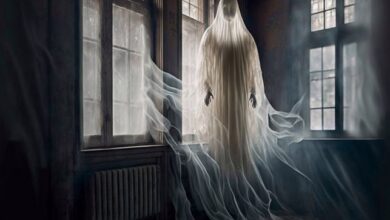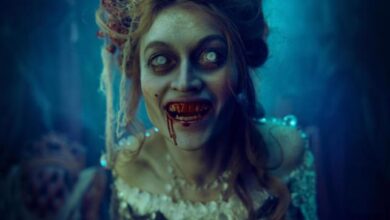It Has a Supernatural, Red-Eyed Relative. Be Careful!

Accounts of glowing-eyed, huge black hounds of an ominous and sometimes deadly kind – and which can take on multiple forms – are significant parts of the story this book tells. They are among the most feared of all shapeshifters, primarily because they are linked to the realm of the dead and the afterlife. If you think it’s tough to serve a life-long jail sentence today, you may want to take a look at life in England’s Newgate Prison, circa the latter part of the 1500s. To say that existence was grim for those destined to die within the infamous prison would be an understatement of epic proportions. And particularly so when you’re also faced with fighting off a marauding entity that is part-human and part-monstrous hound. But, let’s not get too ahead of ourselves. A bit of background on Newgate Prison is first required. The origins of this particularly notorious jail date back to 1188, which was the year in which its huge, creaking doors were first opened. Such was the level of violence that existed in lawless England at the time, the facility was constantly being added to, specifically to cope with the ever-growing band of murderers, rapists, and thieves that came its way. In other words, business was not just good: it was positively blooming. Things remained that way until its doors were finally shut, in 1902.
It was, however, in the 1500s that Newgate Prison earned its reputation as a definitive hellhole. During this period food for the people of London was at its lowest. Malnutrition, starvation, and death were very much the order of the day. Behind the walls of Newgate, however, things were even worse. If such a thing was possible. Yes, unfortunately, it was. Old texts and manuscripts tell of nightmarish scenarios in which the starving, desperate prisoners turned upon one another, literally eating each other alive in cramped, filthy cells and amid a sickening and ever-growing stench of rotting, human flesh. One of those manuscripts, written by Samuel Rowlands, has proven to be a very curious one. Its title, in quaint, old-English style, was The Discovery of a London Monster, called The Blacke Dogg of Newgate: Profitable for all Readers to Take Heed by. Rowlands said that at the very height of the terrible, cannibalistic activity – which even the guards were fearful of trying to stop, lest they, too, became food for the prisoners – a huge black dog suddenly manifested in one of the larger cells, a cell that held more than a dozen criminals.

Rowlands continued that panic-filled mayhem erupted as the red-eyed, canine fiend rampaged around the room, tearing into the bodies of the emaciated prisoners, and ripping away skin, and crunching down on weakened bones. With the cell turned into what looked like some ghoulish slaughterhouse, and the prisoners all quickly and violently dead, the monstrous hound suddenly vanished – as if into thin air itself. Word quickly got around that the supernatural, killer dog was the shape-shifted form of one of the prisoners. He was a man who had been devoured by his fellow prisoners several days earlier, and who had returned in the form of a diabolical hound to take out his very own, unique form of lethal justice. Of the many and varied reports that exist of shapeshifters, there is absolutely no doubt that one of the creepiest sagas of all is that which was splashed across the pages of various newspapers in the summer of 1905. It’s hardly surprising that the story attracted so much attention, given that it was focused on sightings of what can only be accurately described as a beast that was half-human and half-dog.
The Register newspaper – which was published in Rake, Iowa related the facts surrounding the strange saga on June 15. The title of its article came straight to the point: “Dog with a Human Face.” And, just for good measure, the writer of the eerie article added an atmospheric subtitle: “Strange Monstrosity Seen By Many Persons In Colorado Hills – Attempt Capture In Vain.” While the Register’s story got picked up far and wide, it was actually based upon an earlier article – specifically one which appeared in the Pittsburgh Press on May 3, and which was titled, “Strange Animal: Has an Almost Human Face and a Red Mustache.” The collective accounts paint a deeply strange picture. So the story went, for a period of several weeks, sightings had been made of the near-unearthly beast on the hills surrounding Buena Vista, Colorado, and also along the old railroad tracks in Wildhorse, which was a station on the Colorado Midland Railway. So far as can be determined, the first encounter – or, maybe, more correctly, the first reported encounter – took place on a stretch of road that crossed the Arkansas River, which weaves its winding way through Kansas, Oklahoma, Arkansas, and Colorado.
The unfortunate soul who had the distinct bad luck to be in the wrong place at the wrong time was a woman, a local and rich farmer, who was having a leisurely drive across the river – atop a cart pulled by her favorite horse. Upon reaching one particular bridge that spanned the river, she slowed down, puzzled by the sight of some large, unknown animal standing rigidly in the middle of the road. Her first thought was that she was looking at a large dog, wolf, or coyote. There was, however, something decidedly not right about its head. At first, and due to her distance from the animal, she could see that while the body certainly resembled that of a canid, there was something strange about its face. As she got closer, despite the horse became decidedly reluctant to go any further, it became all too clear why that head looked so abnormal. To her horror, the woman could see that, yes, the body was very dog-like. But, it was clearly no dog. Nor was it a wolf or a coyote. That much is sure from her description: the animal had large black spots on its coat, it was of a greyish color, and had extraordinarily long and pointed ears. Its tail seemed to be out of proportion, too. But, that was not the end of it. Far from it. Things were about to get worse. Much worse.
Upon reaching the animal, which still stubbornly refused to move, she could see that its eyes were much closer than one would expect to see on a dog. Not only that, the eyes looked incredibly humanlike. In fact, to her eternal terror, she could see that the whole face looked human. This was amplified by what was a large tuft of hair under its nose which eerily resembled a mustache! The woman’s horse was equally terrified, almost throwing her from the cart as it fought to rear up on its back legs. Suddenly, and just as the woman thought the beast was about to launch a violent attack, the animal issued a woeful howl and headed off into the surrounding undergrowth. Just before vanishing for good, it climbed a small, local peak and turned and peered ominously at the woman – perhaps, in its own wild way, warning her not to follow its tracks. For the witness, however, this was not the most traumatic part of the encounter. As the dog turned its head away from her, and while still on that same peak, it rose up onto its back limbs and stood there in a curious, swaying fashion. And it topped everything off with a loud, ear-piercing howl, before dropping to all-fours and heading back into the undergrowth.

It was not seen again. At least, not by the tortured witness. In the days that followed, however, a wealth of additional accounts reached the staff of the Pittsburgh Press, all of which suggested that the creature had made its home somewhere in the vicinity of the river – which would have made a great deal of sense. After all, the river and its environs offered cover and camouflage, as well as a plentiful supply of water and small animals to feed on. Hardly surprisingly, it was the fact that the monstrosity was half-human and half-beast that really caught the attention and imagination of the press of the day. Despite almost two months of coverage, the affair of the Dog-Man of the Arkansas River came to a halt as June came to a close. The creature was not seen again. There were no reports of it being shot and killed. And, no farm animals were attacked – which would have been a telltale sign of a marauding predator wildly on the loose. The overriding opinion was that, with dozens of gun-toting locals scouring the area, the animal had wisely decided to exit its then-current environment and head off to pastures fresh and new.
So, what was this half-human, half-animal? The short answer is: we don’t know. And we probably never will – unless, of course, others of its kind still, to this very day, haunt certain stretches of the Arkansas River. A case could, perhaps, be made that the animal had a deformed face – a condition, maybe, that gave it an eerily human-like appearance. That does not, however, provide any kind of answer as to how the beast could walk on its back limbs, rather than on all four. And what about that nerve-jangling howl? Taking all of this into consideration, what we are left with appears to be a series of encounters with something that bore all the hallmarks of the classic werewolf, the ultimate predatory shapeshifter. In 1902, one of the most famous, and still very much loved, novels of all time was published. We are talking about Sir Arthur Conan Doyle’s classic story, The Hound of the Baskervilles, which had previously been serialized in the pages of The Strand Magazine, from 1901 to 1902. The book, which has been turned into numerous hit movies and television dramas, tells an adventurous and eerie story. Namely, that of Sherlock Holmes’ and Dr. Watson’s investigation of a murderous, supernatural black dog that haunts the perilous, foggy landscape of Dartmoor, Devon, England. The blazing-eyed beast tasks the intrepid pair to their absolute limits, before finally being defeated in a dramatic, late-night confrontation on the treacherous, foggy moor.
It is, however, a little known fact that Conan Doyle’s story was directly inspired by certain real-life events and characters. The creator of Holmes and Watson was, for example, very aware that, for centuries, reports of such huge, red-eyed hounds had widely been in circulation. And wildly, too. Numerous little villages throughout the U.K. spoke of the deadly, paranormal dogs in their very midst. They were almost always described as shapeshifters. Perhaps the most famous of all of the phantom hounds of old Britain are those that are said to have frequented – and that, in some cases, still frequent – the ancient roads and pathways of the English counties of Norfolk, Essex, Suffolk, and Sussex.
Their names include Black Shuck, the Shug Monkey, and the Shock. The Shuck and the Shock are classic black dogs; whereas, interestingly enough, the Shug Monkey is described as a creature which can change from hound to monkey and back again. Even their very names have intriguing origins: while some researchers consider the possibility that all of the appellations had their origins in the word Shucky – a centuries-old word which means shaggy – others, such as monster-hunter Jonathan Downes, of the Center for Fortean Zoology, offers a far more sinister theory. In his book, Monster Hunter, Downes suggests that Shock, Shuck, and Shug are all based upon the Anglo-Saxon scucca, meaning demon; a most apt description, to be sure. Equally of note and relevance, the phantom black dog would often appear just before, or during, a wild thunder-storm. All of which brings us right back to The Hound of the Baskervilles.
As for one of the two arch-villains in Conan Doyle’s book – Sir Hugo Baskerville – he was based upon an all too real rich and powerful Dartmoor-based squire named Richard Cabell. He was a downright unpleasant and evil man who constantly provoked fear and terror among the locals that lived on the expansive and mysterious moors. That, on the dark and stormy eve of Cabell’s death, a huge pack of black hounds was seen charging across Dartmoor – and under the light of a full moon – demonstrates yet another link between the world of reality and that of atmospheric literature. And talking of the real world vs. fiction…
In 2007, a little more than a century after The Hound of the Baskervilles was published in book form, the worlds of reality and fantasy crossed paths in decidedly sinister and unsettling fashion. It would not be inaccurate to say in incredible fashion, too. And, on Dartmoor itself. It’s a story that revolves around one Martin Whitley, a resident of Devon and someone with a very keen knowledge of the area and the old, sprawling landscape. It was a hot, bright, summer’s day in 2007 when Whitley was busily showing a number of American visitors around the area. All was perfectly normal until something caught his eye. Something very unusual and out of place. Something that looked like it had just leapt out of the dark imagination of Conan Doyle, himself. Except this was all too real. Nor was Whitley a character in an old novel. It was the real deal.
At a distance of around six hundred feet, Whitley saw a large, black-colored mass moving across the moors. Having a camera with him, he focused his telephoto lens on the whatever-it-was and took a good and careful look. He was astonished to see what appeared to be a large dog. “Large,” however, would be an absolute understatement, given that Whitley described the animal as being roughly the size of a pony. He snapped off a bunch of pictures of the beast as it prowled around the old, atmospheric landscape. That was when things got really strange. Actually, things got beyond strange: the fiendish dog began to change its shape. More correctly…it changed species. And, elevating the bizarreness, it did so more than once. Whitley, as he stared through the lens, found himself completely baffled, and more than a little disturbed too, to see the mysterious beast take on various forms. It changed from a dog into what looked very much like a sleek and black mountain lion, from a muscular black bear to a large boar, and even to something that resembled a pony. Despite the way it looked – for a while, at least – Whitley had serious doubts that the creature was some sort of dog, chiefly due to its immense size. So, what was it?

It’s hardly surprising that both the local and the national media had an absolute field day with the story when it broke. It was this huge coverage which prompted a local woman named Lucinda Reid to state that, in all probability, the morphing monster was actually her huge, black-coated pet Newfoundland dog, Troy, out on a fun, leisurely stroll! The U.K’s paranormal research community, however, remained highly doubtful of the possibility that gentle and genial Troy was the cause of all the fuss. Chiefly because, as the photographs clearly demonstrated, the animal appeared to change its shape multiple times, an in a matter of mere minutes. There was something else, too. Something which sent cold shudders up the spines of many. The location of all the action was less than a mile from a huge slab of granite known locally as Bowerman’s Nose; a place where, more than a thousand years earlier, infernal and highly dangerous witches held their terrible rites and rituals of the sacrificial variety. Human sacrifices, that is. Notably, they were also witches that had the ability to shape-shift – most often into the forms of hares and black cats. And we are still not quite done. Nearby Wistman’s Woods have, for centuries, been the rumored territory of a pack of supernatural dogs known as the Wisht Hounds. Add all of those strange components together and what we have is a modern day incarnation of a beast that many are more than content relegated to the world of folklore and to times long gone. And, specifically in relation to playful Troy the dog, to mistaken identity, too.
Sometimes, however, and as this particularly uncanny saga graphically demonstrates, truth is not just stranger than fiction. At times, incredibly, they just might be one and the very same. And right in the heart of the 21st century. The ways, and traditions, of old are still among us, it seems. While there is no doubt that the Phantom Black Dog is perceived as largely being a British phenomenon, it’s a fact that the phenomenon of these strange creatures extends right into the heart of Latin America. We know this largely as a result of the sterling work in this area of a man named Simon Burchell. His research has shown that not only is the shapeshifting Phantom Black Dog an integral part of Latin American lore and legend, but that this specific beast eerily parallels its British cousin – in terms of both its appearance and its supernatural traits and abilities. Indeed, Burchell –in his 2007 book, Phantom Black Dogs in Latin America – notes that the near-ubiquitous glowing red eyes of the beast are very often present in Latin American reports. The connections between death, disaster and the afterlife – in relation to the beastly hounds are noted to a significant degree in Latin America, too. And, in much the same way, the Latin American version of the Phantom Black Dog often presents itself at the likes of graveyards, certain stretches of road, and bridges. And, obviously, there is the ability of the Latin American monster to shapeshift – and even to alter its size.
Interestingly, there is one big difference between the British version and its Latin American cousin. Whereas the U.K.s monster does not impact to any particular degree on the people of the country – aside from those who encounter it, of course – that is not the case in Latin America. Burchell’s studies have shown that in some Latin American countries – and particularly so in Guatemala – the legend of the Phantom Black Dog has been utilized to influence the morals of the population. That may sound very strange, but it is absolutely true. Stories have been spread to the effect that anyone who regularly drinks alcohol might incur the wrath of a Phantom Black Dog. There is no evidence in the slightest that people who drink have a greater chance of seeing the beast, but the fear of the creature appears to have certainly influenced people to cut down on their drinking – something which the Catholic Church, and its outdated morals carefully exploited. One particular difference between the U.K.’s hellhound and that of Latin America is that the latter is often described as having a pair of wings, something which allows it to take to the skies. As this book shows, there are more than a few shapeshifters that have the ability to fly in the air – Mothman, of Point Pleasant, West Virginia, being a classic example.
We will give the final words on this particular matter to Simon Burchell: “Although the Black Dog may appear at first glance to be a British or north European phenomenon, it exists in essentially the same form across the entire length and breadth of the Americas. Much has been written upon the presumed Germanic, Celtic or Indio-European origin of the legend but such an origin would not explain how a highland Maya girl can meet a shape-shifting Black Dog at a Guatemalan crossroads. It appears that the Black Dog, much like the poltergeist, is a global phenomenon.”




